Zhuyun Dai
KEIR @ ECIR 2025: The Second Workshop on Knowledge-Enhanced Information Retrieval
Jan 20, 2025Abstract:Pretrained language models (PLMs) like BERT and GPT-4 have become the foundation for modern information retrieval (IR) systems. However, existing PLM-based IR models primarily rely on the knowledge learned during training for prediction, limiting their ability to access and incorporate external, up-to-date, or domain-specific information. Therefore, current information retrieval systems struggle with semantic nuances, context relevance, and domain-specific issues. To address these challenges, we propose the second Knowledge-Enhanced Information Retrieval workshop (KEIR @ ECIR 2025) as a platform to discuss innovative approaches that integrate external knowledge, aiming to enhance the effectiveness of information retrieval in a rapidly evolving technological landscape. The goal of this workshop is to bring together researchers from academia and industry to discuss various aspects of knowledge-enhanced information retrieval.
Can Long-Context Language Models Subsume Retrieval, RAG, SQL, and More?
Jun 19, 2024


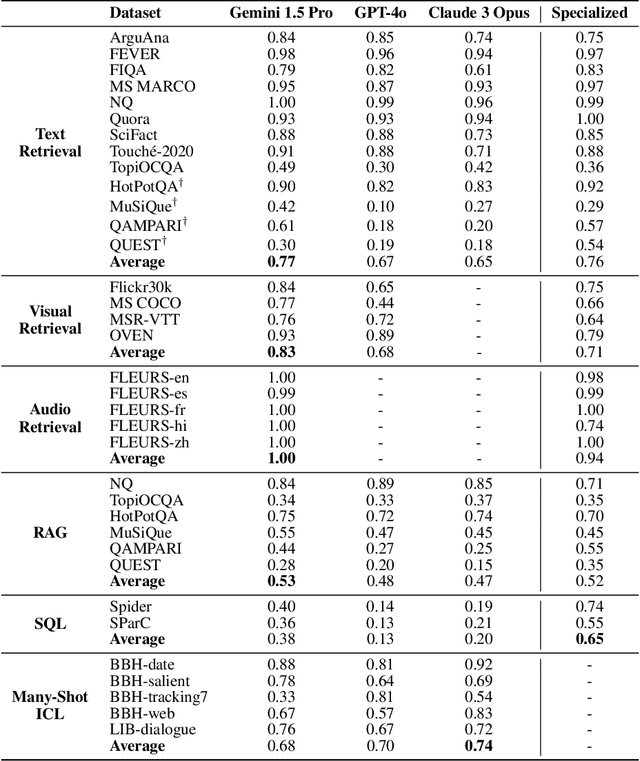
Abstract:Long-context language models (LCLMs) have the potential to revolutionize our approach to tasks traditionally reliant on external tools like retrieval systems or databases. Leveraging LCLMs' ability to natively ingest and process entire corpora of information offers numerous advantages. It enhances user-friendliness by eliminating the need for specialized knowledge of tools, provides robust end-to-end modeling that minimizes cascading errors in complex pipelines, and allows for the application of sophisticated prompting techniques across the entire system. To assess this paradigm shift, we introduce LOFT, a benchmark of real-world tasks requiring context up to millions of tokens designed to evaluate LCLMs' performance on in-context retrieval and reasoning. Our findings reveal LCLMs' surprising ability to rival state-of-the-art retrieval and RAG systems, despite never having been explicitly trained for these tasks. However, LCLMs still face challenges in areas like compositional reasoning that are required in SQL-like tasks. Notably, prompting strategies significantly influence performance, emphasizing the need for continued research as context lengths grow. Overall, LOFT provides a rigorous testing ground for LCLMs, showcasing their potential to supplant existing paradigms and tackle novel tasks as model capabilities scale.
Gecko: Versatile Text Embeddings Distilled from Large Language Models
Mar 29, 2024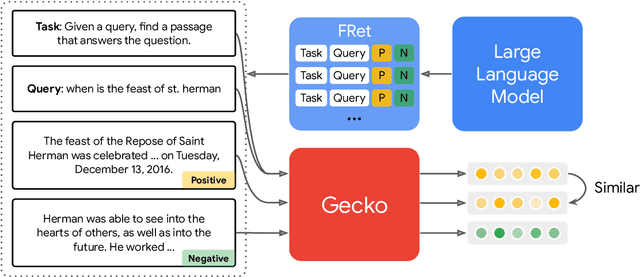


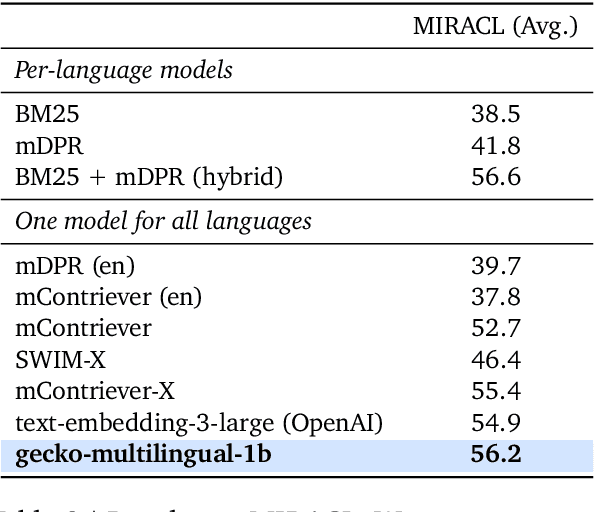
Abstract:We present Gecko, a compact and versatile text embedding model. Gecko achieves strong retrieval performance by leveraging a key idea: distilling knowledge from large language models (LLMs) into a retriever. Our two-step distillation process begins with generating diverse, synthetic paired data using an LLM. Next, we further refine the data quality by retrieving a set of candidate passages for each query, and relabeling the positive and hard negative passages using the same LLM. The effectiveness of our approach is demonstrated by the compactness of the Gecko. On the Massive Text Embedding Benchmark (MTEB), Gecko with 256 embedding dimensions outperforms all existing entries with 768 embedding size. Gecko with 768 embedding dimensions achieves an average score of 66.31, competing with 7x larger models and 5x higher dimensional embeddings.
PaRaDe: Passage Ranking using Demonstrations with Large Language Models
Oct 22, 2023



Abstract:Recent studies show that large language models (LLMs) can be instructed to effectively perform zero-shot passage re-ranking, in which the results of a first stage retrieval method, such as BM25, are rated and reordered to improve relevance. In this work, we improve LLM-based re-ranking by algorithmically selecting few-shot demonstrations to include in the prompt. Our analysis investigates the conditions where demonstrations are most helpful, and shows that adding even one demonstration is significantly beneficial. We propose a novel demonstration selection strategy based on difficulty rather than the commonly used semantic similarity. Furthermore, we find that demonstrations helpful for ranking are also effective at question generation. We hope our work will spur more principled research into question generation and passage ranking.
Dr.ICL: Demonstration-Retrieved In-context Learning
May 23, 2023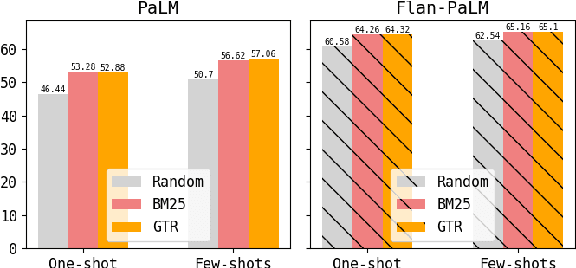


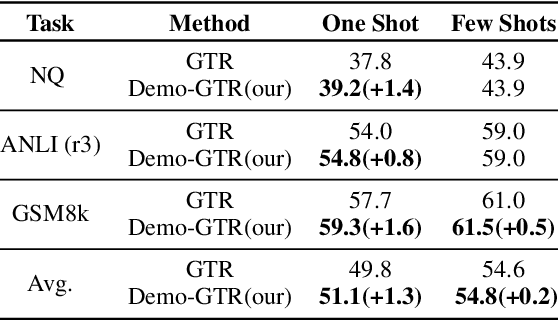
Abstract:In-context learning (ICL), teaching a large language model (LLM) to perform a task with few-shot demonstrations rather than adjusting the model parameters, has emerged as a strong paradigm for using LLMs. While early studies primarily used a fixed or random set of demonstrations for all test queries, recent research suggests that retrieving semantically similar demonstrations to the input from a pool of available demonstrations results in better performance. This work expands the applicability of retrieval-based ICL approaches by demonstrating that even simple word-overlap similarity measures such as BM25 outperform randomly selected demonstrations. Furthermore, we extend the success of retrieval-based ICL to instruction-finetuned LLMs as well as Chain-of-Thought (CoT) prompting. For instruction-finetuned LLMs, we find that although a model has already seen the training data at training time, retrieving demonstrations from the training data at test time yields better results compared to using no demonstrations or random demonstrations. Last but not least, we train a task-specific demonstration retriever that outperforms off-the-shelf retrievers.
Rethinking the Role of Token Retrieval in Multi-Vector Retrieval
Apr 04, 2023Abstract:Multi-vector retrieval models such as ColBERT [Khattab and Zaharia, 2020] allow token-level interactions between queries and documents, and hence achieve state of the art on many information retrieval benchmarks. However, their non-linear scoring function cannot be scaled to millions of documents, necessitating a three-stage process for inference: retrieving initial candidates via token retrieval, accessing all token vectors, and scoring the initial candidate documents. The non-linear scoring function is applied over all token vectors of each candidate document, making the inference process complicated and slow. In this paper, we aim to simplify the multi-vector retrieval by rethinking the role of token retrieval. We present XTR, ConteXtualized Token Retriever, which introduces a simple, yet novel, objective function that encourages the model to retrieve the most important document tokens first. The improvement to token retrieval allows XTR to rank candidates only using the retrieved tokens rather than all tokens in the document, and enables a newly designed scoring stage that is two-to-three orders of magnitude cheaper than that of ColBERT. On the popular BEIR benchmark, XTR advances the state-of-the-art by 2.8 nDCG@10 without any distillation. Detailed analysis confirms our decision to revisit the token retrieval stage, as XTR demonstrates much better recall of the token retrieval stage compared to ColBERT.
Multi-Vector Retrieval as Sparse Alignment
Nov 02, 2022



Abstract:Multi-vector retrieval models improve over single-vector dual encoders on many information retrieval tasks. In this paper, we cast the multi-vector retrieval problem as sparse alignment between query and document tokens. We propose AligneR, a novel multi-vector retrieval model that learns sparsified pairwise alignments between query and document tokens (e.g. `dog' vs. `puppy') and per-token unary saliences reflecting their relative importance for retrieval. We show that controlling the sparsity of pairwise token alignments often brings significant performance gains. While most factoid questions focusing on a specific part of a document require a smaller number of alignments, others requiring a broader understanding of a document favor a larger number of alignments. Unary saliences, on the other hand, decide whether a token ever needs to be aligned with others for retrieval (e.g. `kind' from `kind of currency is used in new zealand}'). With sparsified unary saliences, we are able to prune a large number of query and document token vectors and improve the efficiency of multi-vector retrieval. We learn the sparse unary saliences with entropy-regularized linear programming, which outperforms other methods to achieve sparsity. In a zero-shot setting, AligneR scores 51.1 points nDCG@10, achieving a new retriever-only state-of-the-art on 13 tasks in the BEIR benchmark. In addition, adapting pairwise alignments with a few examples (<= 8) further improves the performance up to 15.7 points nDCG@10 for argument retrieval tasks. The unary saliences of AligneR helps us to keep only 20% of the document token representations with minimal performance loss. We further show that our model often produces interpretable alignments and significantly improves its performance when initialized from larger language models.
Scaling Instruction-Finetuned Language Models
Oct 20, 2022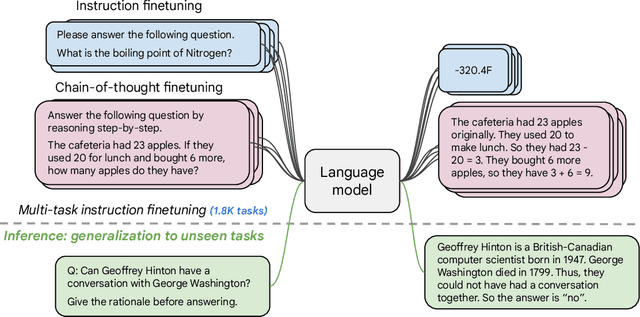
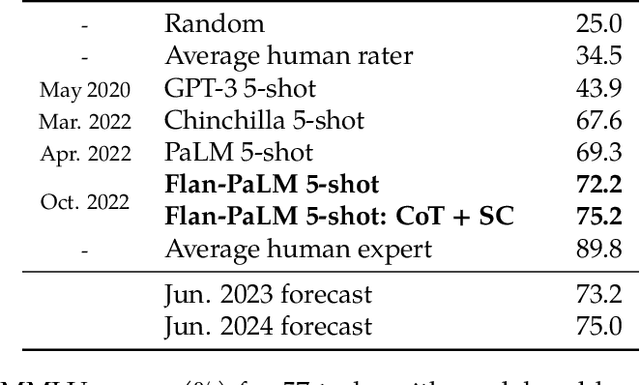
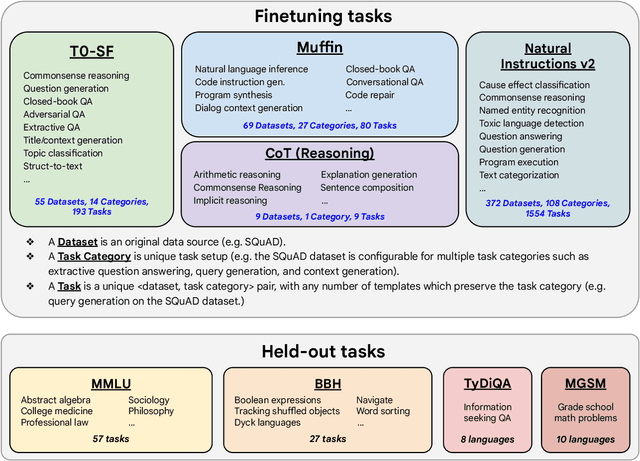
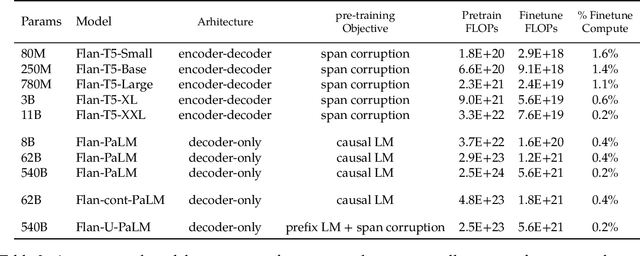
Abstract:Finetuning language models on a collection of datasets phrased as instructions has been shown to improve model performance and generalization to unseen tasks. In this paper we explore instruction finetuning with a particular focus on (1) scaling the number of tasks, (2) scaling the model size, and (3) finetuning on chain-of-thought data. We find that instruction finetuning with the above aspects dramatically improves performance on a variety of model classes (PaLM, T5, U-PaLM), prompting setups (zero-shot, few-shot, CoT), and evaluation benchmarks (MMLU, BBH, TyDiQA, MGSM, open-ended generation). For instance, Flan-PaLM 540B instruction-finetuned on 1.8K tasks outperforms PALM 540B by a large margin (+9.4% on average). Flan-PaLM 540B achieves state-of-the-art performance on several benchmarks, such as 75.2% on five-shot MMLU. We also publicly release Flan-T5 checkpoints, which achieve strong few-shot performance even compared to much larger models, such as PaLM 62B. Overall, instruction finetuning is a general method for improving the performance and usability of pretrained language models.
Attributed Text Generation via Post-hoc Research and Revision
Oct 17, 2022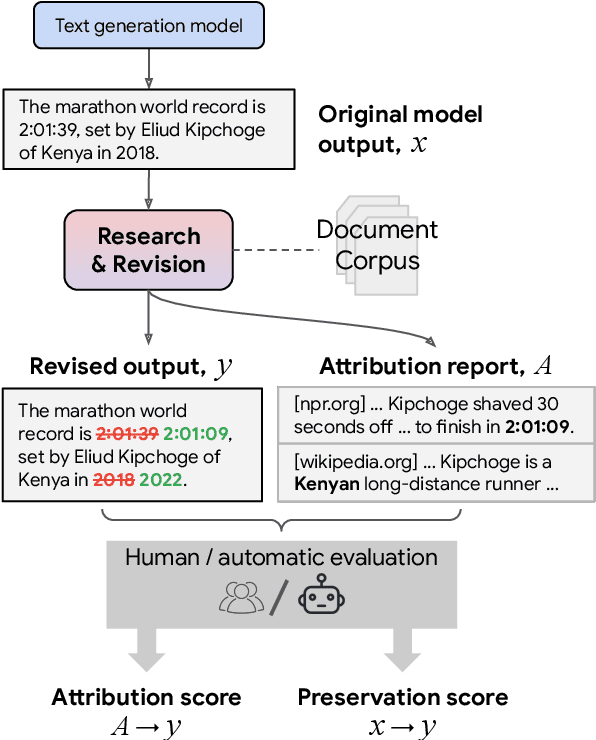

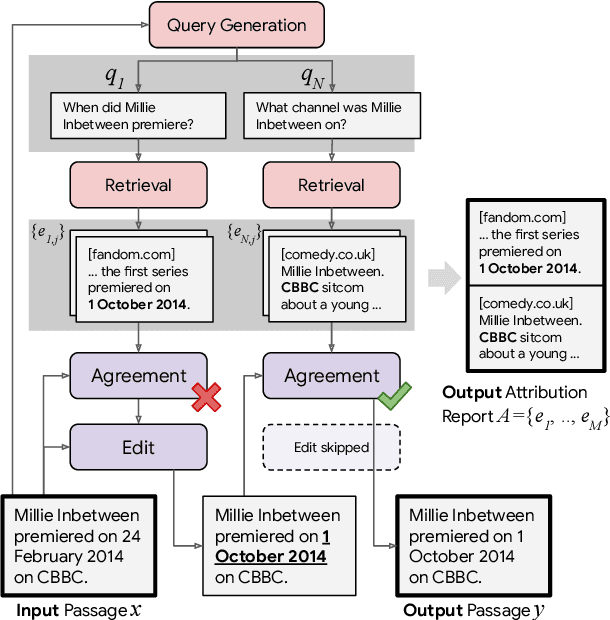

Abstract:Language models (LMs) now excel at many tasks such as few-shot learning, question answering, reasoning, and dialog. However, they sometimes generate unsupported or misleading content. A user cannot easily determine whether their outputs are trustworthy or not, because most LMs do not have any built-in mechanism for attribution to external evidence. To enable attribution while still preserving all the powerful advantages of recent generation models, we propose RARR (Retrofit Attribution using Research and Revision), a system that 1) automatically finds attribution for the output of any text generation model and 2) post-edits the output to fix unsupported content while preserving the original output as much as possible. When applied to the output of several state-of-the-art LMs on a diverse set of generation tasks, we find that RARR significantly improves attribution while otherwise preserving the original input to a much greater degree than previously explored edit models. Furthermore, the implementation of RARR requires only a handful of training examples, a large language model, and standard web search.
Promptagator: Few-shot Dense Retrieval From 8 Examples
Sep 23, 2022

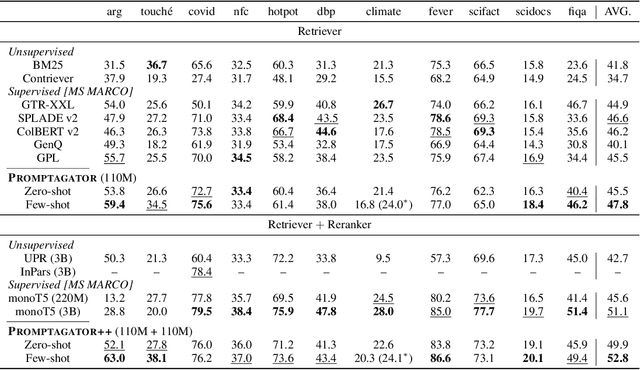

Abstract:Much recent research on information retrieval has focused on how to transfer from one task (typically with abundant supervised data) to various other tasks where supervision is limited, with the implicit assumption that it is possible to generalize from one task to all the rest. However, this overlooks the fact that there are many diverse and unique retrieval tasks, each targeting different search intents, queries, and search domains. In this paper, we suggest to work on Few-shot Dense Retrieval, a setting where each task comes with a short description and a few examples. To amplify the power of a few examples, we propose Prompt-base Query Generation for Retriever (Promptagator), which leverages large language models (LLM) as a few-shot query generator, and creates task-specific retrievers based on the generated data. Powered by LLM's generalization ability, Promptagator makes it possible to create task-specific end-to-end retrievers solely based on a few examples {without} using Natural Questions or MS MARCO to train %question generators or dual encoders. Surprisingly, LLM prompting with no more than 8 examples allows dual encoders to outperform heavily engineered models trained on MS MARCO like ColBERT v2 by more than 1.2 nDCG on average on 11 retrieval sets. Further training standard-size re-rankers using the same generated data yields another 5.0 point nDCG improvement. Our studies determine that query generation can be far more effective than previously observed, especially when a small amount of task-specific knowledge is given.
 Add to Chrome
Add to Chrome Add to Firefox
Add to Firefox Add to Edge
Add to Edge